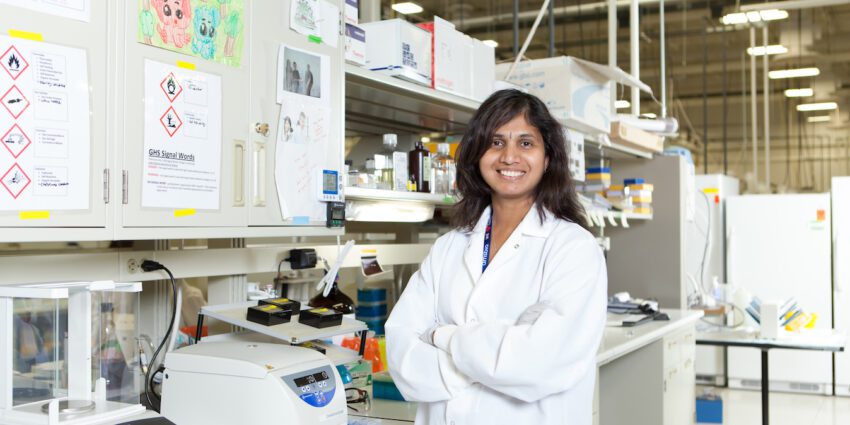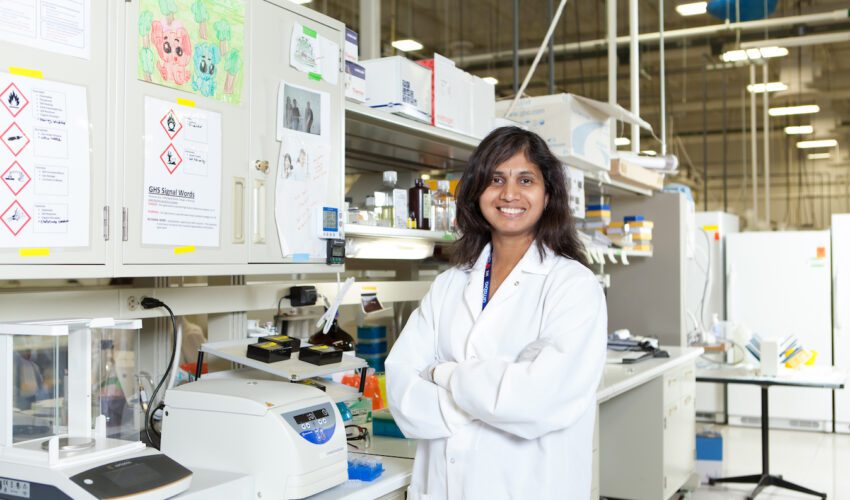Clue to causes of kidney disease: It’s in your cells
Feb. 24, 2021
This paid piece is sponsored by Sanford Health.
More than than 30 percent of Americans are at risk of kidney disease, and nearly 20 percent of all Medicare spending is for kidney disease in patients 65 and older. Yet there is still much not known about the development of kidney disease.
Dr. Indra Chandrasekar and her team of researchers recently published an article in the biomedical research journal JCI Insight, highlighting the impact of key cellular processes on kidney health and function. The discovery allows researchers to better understand how kidney disease forms.
The kidney carries out many functions that are necessary to maintain overall health. As a result, any disruption to those functions can cause kidney disease. To find where the disease starts, the Chandrasekar Lab chose to study functions at the cellular level.
When researchers turned off the genes for certain proteins in mice at 4 weeks of age, the mice began to exhibit worsening dilation of the kidney tubules, accompanied by eventual kidney degeneration and cyst formation by 12 weeks of age. Along with these structural changes came functional changes within the kidneys, including more acidic urine, excretion of protein and salts, and inflammation as the disease progressed.
This work highlights a new and major role for the proteins, called nonmuscle myosin II, or NM2A and NM2B, in maintaining the health and function of the kidneys. This finding provides key knowledge to the kidney disease field as the pursuit of a cure continues to drive the valuable work being performed at Sanford Research.
Chandrasekar sat down to talk about her history with Sanford Research and her recent work.
What does this published work mean to you?
The myosin motor family, and NM2 proteins in particular, has been studied for over five decades. NM2’s role in cell migration, adhesion and cell division has been carefully examined in vitro as well as with organismal and developmental context. Work in the Chandrasekar Lab is focused on understanding the physiological and cell-type specific role for NM2 mediated cellular transport mechanisms using mouse kidney as a model. Turning off the NM2 genes in adult mouse kidney tubular epithelial cells demonstrates that NM2 function is critical for the transport of two important proteins within the kidney. These two proteins are called uromodulin (UMOD) and sodium, potassium, chloride cotransporter (NKCC2) that are essential for maintaining electrolyte balance and blood pressure in our body.
Mutations in UMOD and NKCC2 genes in humans lead to kidney disease. Membrane-associated NKCC2 has been the target of several blood pressure-regulating medicines currently on the market. Therefore, it is critical to further explore and understand how NM2 proteins regulate UMOD and NKCC2 transport and function within the kidney cells.
Personally, this published work has been our team’s mission for the past several years. As the Nobel-prize winning neurobiologist Rita Levi-Montalcini once said, ‘I don’t believe there would be any science at all without intuition.’ The findings described in this manuscript began as an intuition that stemmed from my postdoctoral work. I am very happy with how it turned out and extremely grateful for our team’s hard work.
What led you to use the kidney as your model organ?
As a cell biologist, I am fascinated by the molecular and cellular complexity of the kidney. Considering that mutations in MYH9 (NM2A protein) in humans are linked to kidney disease and that the epithelial cells of the kidney are great models to study cellular transport pathways, it was an easy organ of choice. Moreover, the availability of excellent mouse genetic tools to perform cell-type specific, inducible and conditional gene inactivation in the kidney is also a positive.
What impact does this work have on your field of study?
The impact of our published work is twofold:
- MYH9-related disorders that include May-Hegglin, Sebastian and Epstein syndrome result in end-stage kidney disease in at least one-third of the patients that harbor the MYH9 gene mutation. Previous animal models tested the role of MYH9 in podocytes, a cell-type essential for glomerular filtration that did not yield a disease phenotype. Given that we previously described a novel functional role of NM2 proteins in membrane remodeling events in cells, we tested their role in kidney epithelial cells and established that they play critical roles in cellular transport pathways in the kidney and loss of function can lead to progressive kidney disease of tubular origin. This finding warrants a reevaluation of phenotypes associated with MYH9-related disorders.
- NM2’s role in transport of GPI-anchored protein (UMOD) and transmembrane protein (NKCC2) to the apical membrane is very novel; our work will be the first to report it. Future work in the lab is focused on the subcellular site and mechanism of action of NM2 along the anterograde transport pathway of specialized cargo proteins.
What sparked your interest in cell biology?
I worked at a local clinical laboratory in town during the first year of my undergraduate biochemistry program. My job was to prepare, stain and perform microscopic analysis of peripheral blood smears from patient blood. I was fascinated by the cellular morphology, staining characteristics and intracellular organelles present in the varying types of blood cells. I wanted to understand how different cell types in our body function and what happens when they do not perform their assigned jobs. This interest led me to Dr. Brigitte M. Jockusch’s laboratory in Germany for my graduate work. Professor Jockusch is a well-respected expert in the field of cytoskeletal research and cell biology. Being in her lab was a great privilege. I continued my training with prominent cell biologists such as Dr. John A. Cooper and Dr. Paul C. Bridgman at Washington University in St. Louis.
What drew you to Sanford Research?
During my training as a postdoctoral scientist at Washington University in St. Louis, I had determined a new, critical role for nonmuscle myosin 2 (NM2) motors in processes by which proteins are transported into and within cells. At Sanford Research, I got the opportunity to follow on my previous findings and to start an independent research program to understand the molecular mechanisms underlying kidney tubular transport defects to human kidney diseases. The excellent, state-of-the-art facilities to conduct basic and clinical research at Sanford Research has led us to publish a manuscript of high impact that reports that the loss of NM2 proteins in adult kidney epithelium results in progressive chronic kidney disease.
What is your favorite part of your job?
I enjoy thinking about new ideas and concepts and testing those using experiments in the lab to gain insights into cellular mechanisms. I love performing advanced microscopy experiments. However, the most enjoyment comes from passing along the valuable techniques and scientific concepts to future scientists who are trainees and let them excel in whatever they desire in their life.








